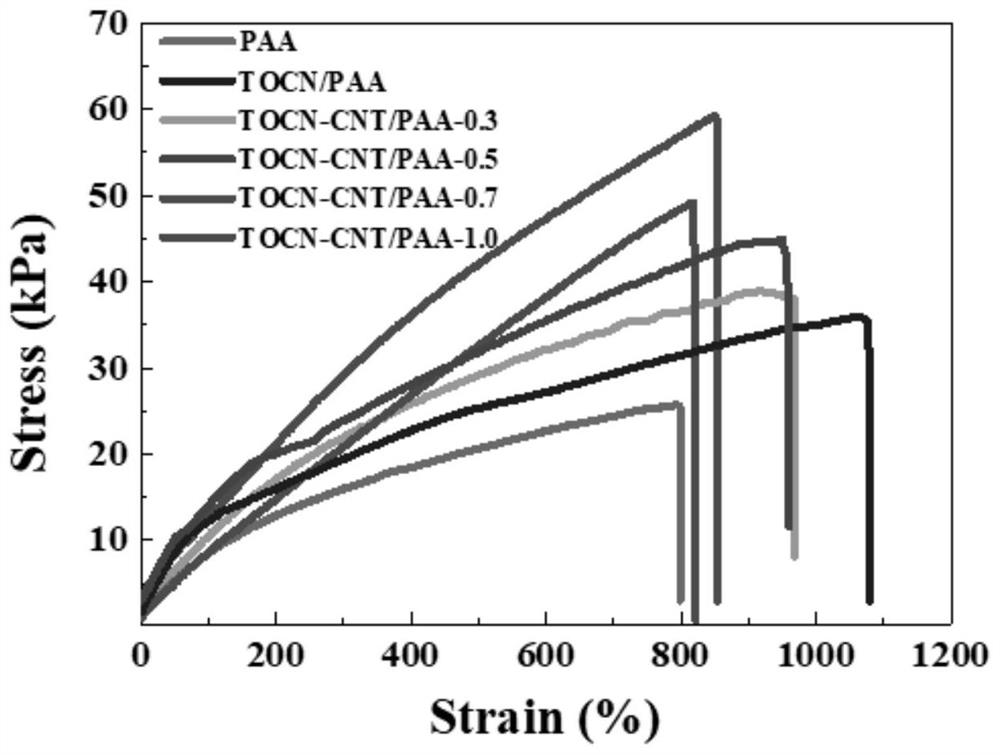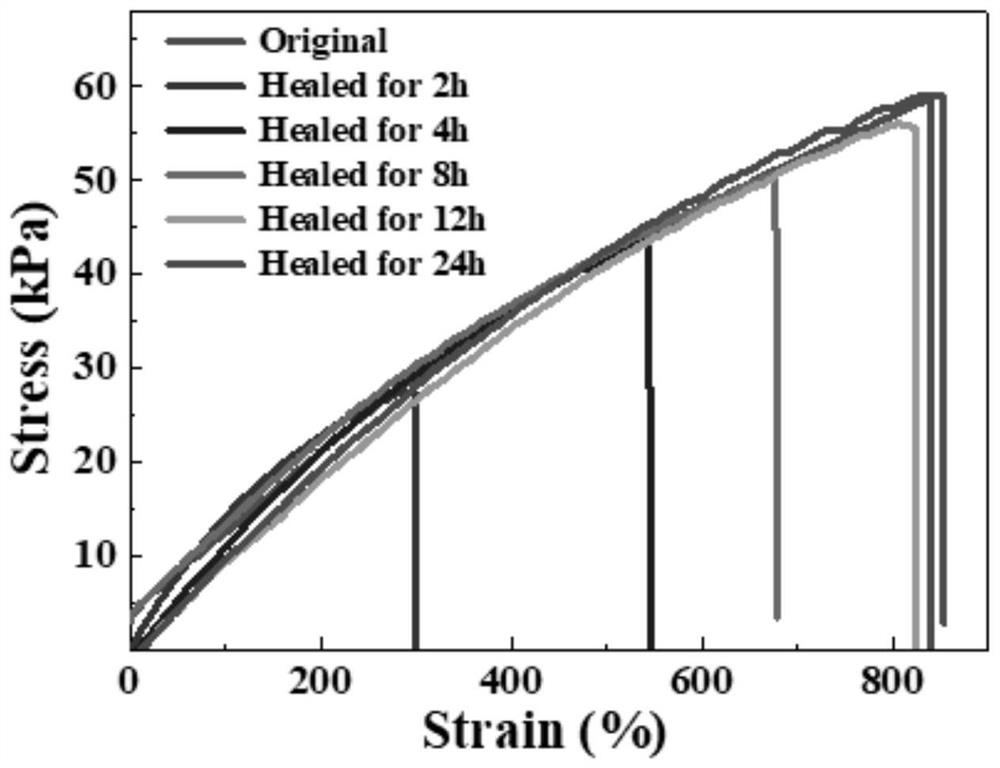Preparation method and application method of tempo nano cellulose-polyacrylic acid gel
A polyacrylic acid gel, nanocellulose technology, applied in the field of polymer composite conductive materials
- Summary
- Abstract
- Description
- Claims
- Application Information
AI Technical Summary
Problems solved by technology
Method used
Image
Examples
Embodiment 1
[0063] Step 1, the preparation of TEMPO nano-cellulose suspension, its concrete method step comprises:
[0064] (1) Weigh 0.02g of TEMPO and 0.2g of NaBr into 300mL of deionized water in sequence, and stir the above mixture fully with a magnetic stirrer at 5°C. After TEMPO and NaBr are completely dissolved, add 1 g of pulverized bleached wood pulp fiber powder to the reaction system; (2) stir vigorously until the cellulose is evenly dispersed, then add 20 g of NaClO to the system, and add 0.4 mol L -1 NaOH solution to control the pH of the reaction system at about 9; (3) filter the oxidized cellulose after reacting for 5 hours, and wash with deionized water for 3 to 5 times to obtain oxidized cellulose; (4) use deionized water to filter the oxidized cellulose Supplemented as 1mg ml -1 In an ice-water bath, oxidized cellulose was peeled off into cellulose nanofibers by ultrasonication at 200W power for 4 minutes, and the prepared fiber nanofiber suspension was stored in a refr...
Embodiment 2
[0070] Step 1, the preparation of TEMPO nano-cellulose suspension, its concrete method step comprises:
[0071] (1) Weigh 0.033g of TEMPO, and add 0.33g of NaBr into 400mL of deionized water in turn, and stir the above mixture fully with a magnetic stirrer at 10°C. After TEMPO and NaBr are completely dissolved, add 2 g of pulverized bleached wood pulp fiber powder to the reaction system; (2) stir vigorously until the cellulose is evenly dispersed, then add 20 g of NaClO to the system, and add 0.5 mol L -1 NaOH solution to control the pH of the reaction system at about 10; (3) filter the oxidized cellulose after reacting for 6 hours, and wash with deionized water for 3 to 5 times to obtain oxidized cellulose; (4) use deionized water to filter the oxidized cellulose Supplemented into 2mg ml -1 In an ice-water bath, oxidized cellulose was peeled off into cellulose nanofibers by ultrasonication at 300W power for 5 minutes, and the prepared fiber nanofiber suspension was stored in...
Embodiment 3
[0077] Step 1, the preparation of TEMPO nano-cellulose suspension, its concrete method step comprises:
[0078](1) Weigh 0.033g of TEMPO, and add 0.33g of NaBr into 400mL of deionized water in turn, and stir the above mixture fully with a magnetic stirrer at 10°C. After TEMPO and NaBr are completely dissolved, add 2 g of pulverized bleached wood pulp fiber powder to the reaction system; (2) stir vigorously until the cellulose is evenly dispersed, then add 21 g of NaClO to the system, and add 0.5 mol L -1 NaOH solution to control the pH of the reaction system at about 10; (3) filter the oxidized cellulose after reacting for 6 hours, and wash with deionized water for 3 to 5 times to obtain oxidized cellulose; (4) use deionized water to filter the oxidized cellulose Supplemented into 2mg ml -1 In an ice-water bath, oxidized cellulose was peeled off into cellulose nanofibers by ultrasonication at 300W power for 5 minutes, and the prepared fiber nanofiber suspension was stored in ...
PUM
| Property | Measurement | Unit |
|---|---|---|
| strength | aaaaa | aaaaa |
| carrier mobility | aaaaa | aaaaa |
| tensile strength | aaaaa | aaaaa |
Abstract
Description
Claims
Application Information
 Login to View More
Login to View More - R&D
- Intellectual Property
- Life Sciences
- Materials
- Tech Scout
- Unparalleled Data Quality
- Higher Quality Content
- 60% Fewer Hallucinations
Browse by: Latest US Patents, China's latest patents, Technical Efficacy Thesaurus, Application Domain, Technology Topic, Popular Technical Reports.
© 2025 PatSnap. All rights reserved.Legal|Privacy policy|Modern Slavery Act Transparency Statement|Sitemap|About US| Contact US: help@patsnap.com



